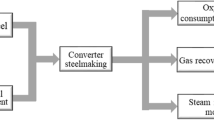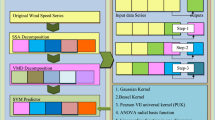Abstract
Heat rate value is considered as one of the most important thermal economic indicators, which determines the economic, efficient and safe operation of steam turbine unit. At the same time, an accurate heat rate forecasting is core task in the optimal operation of steam turbine unit. Recently, least squares support vector machine (LSSVM) is being proved an effective machine learning technique for solving nonlinear regression problem with a small sample set. However, it has also been proved that the prediction precision of LSSVM is highly dependent on its parameters, which are hardly choosing for the LSSVM. In the paper, an improved gravitational search algorithm (AC-GSA) is presented to further enhance optimal performance of GSA, and it is employed to serve as an approach for pre-selecting LSSVM parameters. Then, a novel soft computing method, based on LSSVM and AC-GSA, is therefore proposed to forecast heat rate of a 600 MW supercritical steam turbine unit. It combines the merits of the high accuracy of LSSVM and the fast convergence of GSA in order to build heat rate prediction model and obtain a well-generalized model. Results indicate that the developed AC-GSA–LSSVM model demonstrates better regression precision and generalization capability.









Similar content being viewed by others
References
Zhang W, Niu P, Li G et al (2013) Forecasting of turbine heat rate with online least squares support vector machine based on gravitational search algorithm. Knowl-Based Syst 39:34–44
Liu C, Niu P, You X (2014) Application of reversed modeling method in prediction of steam turbine heat rate. J Chin Soc Power Eng 34(11):867–872
Xiande Fang YX (2011) Development of an empirical model of turbine efficiency using the Taylor expansion and regression analysis. Energy 36(5):2937–2942
Huang J, Wu X (1993) Derivation of characteristic equations for 300 MW extraction condensing turbine sets with multivariable linear regressing. J Power Eng 4:16–20
Ding S, Ma G, Shi Z (2014) A rough RBF neural network based on weighted regularized extreme learning machine. Neural Process Lett 40(3):245–260
Aladag CH, Yolcu U, Egrioglu E (2013) A new multiplicative seasonal neural network model based on particle swarm optimization. Neural Process Lett 37(3):251–262
Shen Y, Miao P, Huang Y et al (2015) Finite-time stability and its application for solving time-varying sylvester equation by recurrent neural network. Neural Process Lett 42(3):763–784
Hafiz AR, Al-Nuaimi AY, Faijul Amin M et al (2015) Classification of skeletal wireframe representation of hand gesture using complex-valued neural network. Neural Process Lett 42(3):649–664
Cui L, Wang X, Zhang Y (2016) Reinforcement learning-based asymptotic cooperative tracking of a class multi-agent dynamic systems using neural networks. Neurocomputing 171:220–229
Wang L, Zhang X, Wang H et al (2007) Model for the turbine heat rate based on the support vector regression. J Power Eng 27:19–23
Peifeng N, Weiping Z (2012) Model of turbine optimal initial pressure under off-design operation based on SVR and GA[J]. Neurocomputing 78(1):64–71
Suykens JAK, Vandewalle J (1999) Least squares support vector machines classifiers. Neural Process Lett 9(3):293–300
Li QL, Song Y, Hou ZG (2015) Estimation of lower limb periodic motions from sEMG using least squares support vector regression. Neural Process Lett 41(3):371–388
Chen X, Yang J, Liang J (2011) Optimal locality regularized least squares support vector machine via alternating optimization. Neural Process Lett 33(3):301–315
Yang JL, Li HX, Hu Y (2011) A probabilistic SVM based decision system for pain diagnosis. Expert Syst Appl 38(8):9346–9351
Yang L, Yang S, Li S et al (2015) Coupled compressed sensing inspired sparse spatial-spectral LSSVM for hyperspectral image classification. Knowl-Based Syst 79:80–89
Wahab NIA, Mohamed A (2009) Transient stability assessment of a large actual power system using least squares support vector machine with enhanced feature selection. Int J Electr Eng Inform 2:103–114
Juncai X, Qingwen R, Zhenzhong S (2015) Prediction of the strength of concrete radiation shielding based on LS-SVM. Ann Nucl Energy 85:296–300
Chen T-T, Lee S-J (2015) A weighted LS-SVM based learning system for time series forecasting. Inf Sci 299:99–116
Yuan X, Chen C, Yuan Y et al (2015) Short-term wind power prediction based on LSSVM-GSA model. Energy Convers Manag 101:393–401
Gao Y, Liu S, Li F et al (2016) Fault detection and diagnosis method for cooling dehumidifier based on LS-SVM NARX model. Int J Refrig 61:69–81
Liu X, Bo L, Luo H (2015) Bearing faults diagnostics based on hybrid LS-SVM and EMD method. Measurement 59:145–166
Rashedi E, Nezamabadi-pour H, Saryazdi S (2009) GSA: a gravitational search algorithm. Inf Sci 179(13):2232–2248
de Moura Oliveira PB, Solteiro Pires EJ, Novais P (2015) Design of Posicast PID control systems using a gravitational search algorithm. Neurocomputing 167:18–23
Shams M, Rashedi E, Hakimi A (2015) Clustered-gravitational search algorithm and its application in parameter optimization of a low noise amplifier. Appl Math Comput 258:436–453
Rezaei M, Nezamabadi-pour H (2015) Using gravitational search algorithm in prototype generation for nearest neighbor classification. Neurocomputing 157:256–263
Jiang S, Wang Y, Ji Z (2014) Convergence analysis and performance of an improved gravitational search algorithm. Appl Soft Comput 24:363–384
Xiang J, XiaoHong H, Duan F (2015) A novel hybrid system for feature selection based on an improved gravitational search algorithm and k-NN method. Appl Soft Comput 31:293–307
Niu P, Liu C, Li P, Li G (2015) Optimized support vector regression model by improved gravitational search algorithm for flatness pattern recognition [J]. Neural Comput Appl 26(5):1167–1177
Zhao X (2010) A perturbed particle swarm algorithm for numerical optimization. Appl Soft Comput 10:119–124
Gaxiola F, Melin P, Valdez F et al (2016) Optimization of type-2 fuzzy weights in backpropagation learning for neural networks using GAs and PSO. Appl Soft Comput 38:860–871
Karaboga D, Basturk B (2007) A powerful and efficient algorithm for numerical function optimization: artificial bee colony (ABC) algorithm. J Glob Optim 39(3):459–471
Yurtkuran A, Emel E (2015) An adaptive artificial bee colony algorithm for global optimization. Appl Math Comput 271:1004–1023
Liu C, Niu P, Li G et al (2015) Enhanced shuffled frog-leaping algorithm for solving numerical function optimization problems. J Intell Manuf. doi:10.1007/s10845-015-1164-z
Gao W, Liu S, Huang L (2012) A global best artificial bee colony algorithm for global optimization. J Comput Appl Math 236(11):2741–2753
Jiang H, Yan Z, Liu X (2013) Melt index prediction using optimized least squares support vector machines based on hybrid particle swarm optimization algorithm. Neurocomputing 119:469–477
Zhang L, Ke W, Zhong Y et al (2008) A new sub-pixel mapping algorithm based on a BP neural network with an observation model. Neurocomputing 71(10–12):2046–2054
Wang HS, Wang YN, Wang YC (2013) Cost estimation of plastic injection molding parts through integration of PSO and BP neural network. Expert Syst Appl 40(2):418–428
Wang Y, Cuijie L, Zuo C (2015) Coal mine safety production forewarning based on improved BP neural network. Int J Min Sci Technol 25(2):319–324
Ren C, An N, Wang J et al (2014) Optimal parameters selection for BP neural network based on particle swarm optimization: a case study of wind speed forecasting. Knowl-Based Syst 56:226–239
Athworks M (1998) Neural network toolbox user’s guide. Mathworks Inc, Natick
Acknowledgments
This research was supported by the National Natural Science Foundation of China (Grant nos. 61403331, 61573306), and China Postdoctoral Science Foundation (Grant No. 2015M571280), and Natural Science Foundation of Hebei Province(Grant No. F 2016203427).
Author information
Authors and Affiliations
Corresponding author
Rights and permissions
About this article
Cite this article
Liu, C., Niu, P., Li, G. et al. A Hybrid Heat Rate Forecasting Model Using Optimized LSSVM Based on Improved GSA. Neural Process Lett 45, 299–318 (2017). https://doi.org/10.1007/s11063-016-9523-0
Published:
Issue Date:
DOI: https://doi.org/10.1007/s11063-016-9523-0




